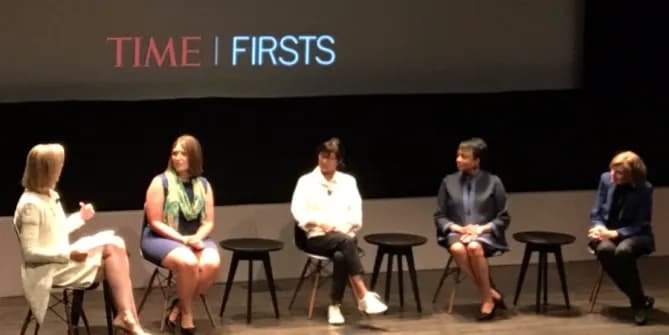4 Glass-Ceiling Shatterers Dish On What It’s Like To Change The World
What do a scientist, architect, football coach and librarian have in common?
On the surface, not much. But four women in these professions were honored together on Tuesday night (Sept. 12) at an event that launched TIME Firsts, a multimedia project celebrating 46 trailblazing women, including Oprah Winfrey, Serena Williams, and Hillary Rodham Clinton.
Four of the women featured in the project — Sylvia Earle, the first woman to be named chief scientist of the U.S. National Oceanic and Atmospheric Administration; Maya Lin, the first woman to design a memorial on the national mall; Kathryn Smith, the first female coach in the NFL; and Carla Hayden, the first woman and first African American to be Librarian of Congress — were joined by Nancy Gibbs (the first woman to serve as editor of TIME, a Time Inc. publication) to discuss their careers and their take on their glass ceiling-shattering experiences. While they all pursued distinct ambitions, they seemed to agree on one thing: their achievements stemmed not from the intention of becoming a pioneering feminist, but simply because they followed they followed their passions with unwavering determination.
Earle put it simply: “I wanted to be a scientist [no matter what] that meant. It wasn’t about labels.” Hayden similarly recalled that she didn’t have much of an internal debate when considering her career path. “I had strong women in the family, and my grandmother made sure her daughters went to college,” she explained. “I had my mom and my aunt [to look up to], so it was like, ‘Of course you're going to get a PhD.’”
Lin credited part of her success to the fact that she was naive about gender and racial discrimination. Both her parents were artists, and she explained that she was raised in a house where her thoughts and ideas — and fighting for her beliefs — was what mattered most.
Smith, who grew up playing with her older brother and his friends, didn’t think twice about doing the same things they did. “I was the youngest and I was a girl,” she said. She remembers thinking, “If they can do that, I can do that, too.”
Still, in spite of their shared resolve to follow their dreams without hesitation, each of the women reflected on the biases they faced along the way. Lin spoke about being “seen through a girl lens,” pointing out that when she’s been featured in the news and media, writers always begin by describing her physical attributes. Earle and her female colleagues — who were living under water as part of a marine biology study in 1969 — were often referred to as aqua-babes, aqua-chicks, or aqua-naughties, and were frequently asked whether they used a hair dryer and wore lipstick. Hayden was told she didn’t look like a librarian, and Smith had trouble getting access to locker rooms during away games (which, of course, was never an issue for her male colleagues).
Gibbs, who moderated the discussion, stressed the importance of sharing these anecdotes. “The response to [the TIME Firsts Project] already has been so inspiring,” she told the panelists. “We keep hearing how valuable it is for girls to get to hear your stories.”
Gibbs also pointed out that while it’s crucial to recognize these women and highlight their experiences, the overall end goal is to not have to celebrate them. "We will look to the day when we don't actually celebrate someone breaking the glass ceiling,” she said. “We'll celebrate its disappearance.”
Why women love us:
- Daily articles on career topics
- Jobs at companies dedicated to hiring more women
- Advice and support from an authentic community
- Events that help you level up in your career
- Free membership, always
